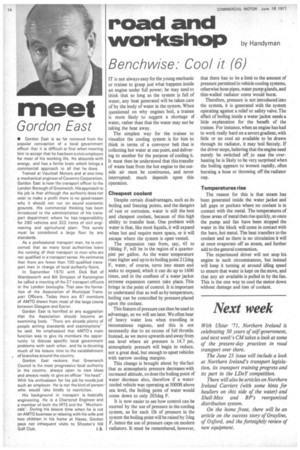road and
Page 76

If you've noticed an error in this article please click here to report it so we can fix it.
workshop by Handyman
Benchwise: Cool it (6)
IT is not always easy for the young mechanic or trainee to grasp just what happens inside an engine under full power; he may tend to think that so long as the system is full of water, any heat generated will be taken care of by the body of water in the system. When questioned on why engines boil, a trainee is more likely to suggest a shortage d water, rather than that the water may not be taking the heat away.
The simplest way for the trainee to visualize the cooling system is for him to think in terms of a conveyor belt that is collecting hot water at one point, and delivering to another for the purpose of cooling it. It must then be understood that this transfer of waste heat from the hot engine to the outside air must be continuous, and never interrupted; much depends upon this operation.
Cheapest coolant
Despite certain disadvantages, such as its boiling and freezing points, and the dangers of rust or corrosion, water is still the best and cheapest coolant, because of this high ability to transfer heat. One problem with water is that, like most liquids, it will expand when hot and require more space, or it will escape where the system is open vented.
The expansion rate from, say, 45 to 180deg F, will be in the region of a quarterpint per gallon. As the water temperature rises higher and up to its boiling point 212deg F, water, of course, turns into steam and seeks to expand, which it can do up to 1600 times, and in the confines of a water jacket extreme expansion cannot take place. This brings in the point of control. It is important to understand that as well as by temperature, boiling can be controlled by pressure placed upon the coolant.
This feature of pressure can then be used to advantage, as we will see later. We often hear of heavy water loss when travelling in mountainous regions, and this is not necessarily due to an excess of full throttle. Instead, as we move upwards and away from sea level where air pressure is 14.7 psi, atmospheric pressure will begin to reduce, not a great deal, but enough to upset vehicles with narrow cooling margins.
This change is brought about by the fact that as atmospheric pressure decreases with increased altitude, so does the boiling point of water decrease also, therefore if a watercooled vehicle was operating at 500011 above sea level, the boiling point of water would come down to only 203deg F.
It is now easier to see how control can be exerted by the use of Pressure in the cooling system, as for each lib of pressure in the system the boiling point will be raised by 3deg F, hence the use of pressure caps on modern radiators. It must be remembered, however, that there has to be a limit to the amount of pressure permitted in vehicle cooling systems, otherwise hose pipes, water pump glands, and thin-walled radiator cores would burst.
Therefore, pressure is not introduced into the system, it is generated with the system operating against a relief or safety valve. The effect of boiling inside a water jacket needs a little explanation for the benefit of the trainee. For instance, when an engine has had to work really hard on a severe gradient, with little or no cool air available to be drawn through its radiator, it may boil fiercely. If the driver stops, believing that the engine need merely be switched off, to ease the overheating he is likely to be very surprised when the boiling appears to worsen rapidly, often bursting a hose or throwing off the radiator cap.
Temperatures rise
The reason for this is that steam has been generated inside the water jacket and left gaps or pockets where no coolant is in contact with the metal. The temperatures of these areas of metal then rise quickly, so once the pump and fan have been stopped the water in the block will come in contact with the bare, hot metal. The heat transfers to the coolant and as there is no circulation it will at once evaporate off as steam, and further add to the general commotion.
The experienced driver will not stop his engine in such circumstances, but instead will keep it turning at around idling speed to ensure that water is kept on the move, and that any air available is pulled in by the fan. This is the one way to cool the motor down without damage and loss of coolant.
































































































































